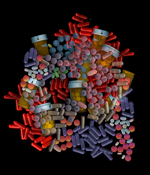The use of antipsychotic drugs to treat very young children appears to be on the rise. That’s the conclusion of a recent study conducted by researchers at Rutgers and Columbia universities. The study, published in the January edition of Journal of the American Academy of Child & Adolescent Psychiatry, examined a large database of privately insured children. The study team found that the percentage of children aged 2 to 5 who were treated with antipsychotics during the year doubled between from 2001 to 2007 and now stands at about 1.76 per 1,000 children. One of the researchers, Professor Stephen Crystal, director of the Rutgers’ Center for Health Services Research on Pharmacotherapy, discussed the findings with Rutgers Today. The other Rutgers co-authors are Tobias Gerhard and Cecilia Huang.

The New York Times' article on Rutgers-Columbia study
Crystal: Historically, this class of drugs was primarily reserved for serious psychotic conditions and was associated in people’s minds with schizophrenia, and other serious mental illnesses. In recent years their use has expanded to a broadened range of conditions and subpopulations, some with stronger evidence of effectiveness than others. For children under 6, few clinical trials have been conducted to establish effectiveness, and there are concerns that adverse effects, especially endocrine and metabolic abnormalities including substantial weight gain, may be especially pronounced in young children. Perhaps the greatest concern in this age group is the “unknown unknowns”, those risks that are not only difficult to predict for an individual but very difficult to study even statistically. This has to do especially with the long-term effects of treatments on the developing brain, which is undergoing such dramatic change and remodeling in the preschool years.
Rutgers Today: What were some of the results that jumped out at you?
Crystal: One of the things that actually surprised me, and the lead writer Mark Olfson (of Columbia University), was that we thought (the children receiving the prescriptions) would reflect a greater predominance of severely damaged kids. What comes to mind, say for a four year old, receiving these kinds of drugs, is a kid with autism, a kid with developmental disabilities. What you found, is that a substantial share hadn’t received diagnoses more serious than ADHD (Attention Deficit Hyperactivity Disorder). Of course, ADHD can be extremely challenging, but we were struck with the fact that kids with diagnoses like autism or mental retardation didn’t account for more of the antipsychotic use.
Rutgers Today: The study also reports that less than half of the children treated with antipsychotic medication did not receive a mental health assessment, a psychotherapy visit, or treatment from a psychiatrist during the year of antipsychotic use. What conclusions can we draw from that information?
Crystal: I think that these kinds of findings may be suggestive of the difficulty that families often experience in accessing expert mental health services for children, in our decentralized health care system. Certainly, a lot of work is needed to better understand what is going on, and what are the barriers for people getting to the right settings. In the background is the fact that for all kids, privately insured, or Medicaid, it’s not very easy, for a whole lot of reasons, to get services. There is a very limited supply of child psychiatrists, and they are booked up and expensive. And you have to go through hoops to get these services. There is a real need for more access to good quality services provided through interdisciplinary teams including disciplines like social work, and that include an emphasis on family counseling and evidence based psychosocial interventions, not just treatment that is primarily pharmacological.
Rutgers Today: Should the public or medical community be alarmed by your findings?
Crystal: I would use the word concerned. I think we are scientists, and we will proceed one step at a time. This is just one piece of a larger puzzle. It’s the kind of thing that provides more questions than answers, but it provides important questions.”